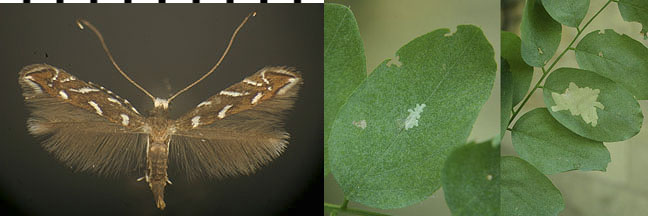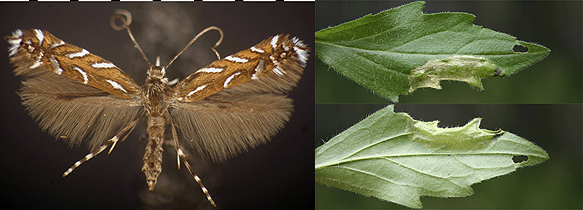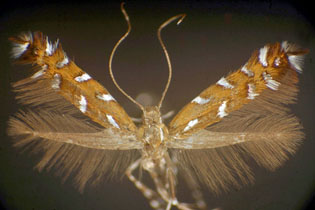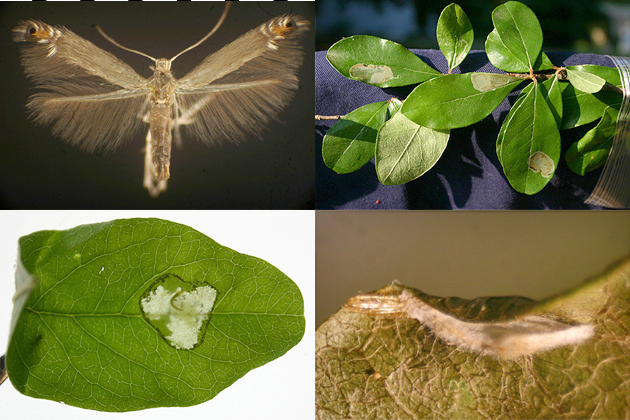
Adults of most species of Parectopa are strikingly-colored gracillariids, the color pattern of the forewing often being rusty brown with angled white dashes on the anterior and posterior margins. Larvae feed in upperside blotch leaf mines on both forbs and woody plants. Several species are known to occur in Illinois.
Parectopa robiniella (Fig. 1) is a commonly-occurring leaf miner on black locust, Robinia pseudoacacia (Fabaceae); it also has been reared in central Illinois from a woodland species of Desmodium (Fabaceae). The leaf mine, which is a flat, yellowish upperside blotch, somewhat resembles that of Chrysaster ostensackenella (which also feeds on Robinia) but differs in being characteristically irregular in outline, such that it is often termed "digitate" (i.e., having "finger-like" excavations all around the margins of the central blotch).

Figure 1. Parectopa robiniella. Adult, and early and mature leaf mines on black locust, Robinia pseudoacacia (Fabaceae).
The larva of Parectopa plantaginisella (Fig. 2) lives in a yellowish blotch leaf mine, on plantain, Plantago sp. (Plantaginaceae) and on fleabane, Erigeron sp. (Asteraceae). In the mature leaf mine, the upper and lower layers of leaf epidermis become widely separated, giving the mine a noticeably puffy appearance.

Figure 2. Parectopa plantaginisella. Adult, and leaf mine on fleabane, Erigeron sp. (Asteraceae).
Parectopa pennsylvaniella (Fig. 3) reportedly is a leaf blotch miner on asters. It has been collected in Illinois as an adult in June.

Figure 3. Parectopa pennsylvaniella. Adult, collected diurnally as half of mating pair, 10 June, Coles County, Illinois.
Parectopa occulta (Fig. 4) is a leaf miner on clover, Melilotus sp. (Fabaceae). Adults occur from June through August in Illinois, with a possible second generation emerging in October. The adult is similar in appearance to Micrurapteryx salicifoliella.

Figure 4. Parectopa occulta. Adult, reared from leaf mine on clover, Melilotus sp. (Fabaceae).
Parectopa bumeliella (Fig. 5) is a leaf miner on Sideroxylon (formerly Bumelia) spp. (Sapotaceae), namely S. lanuginosum and S. lycioides. The mine begins as an upperside track and later expands into an upperside blotch, the upper layer of which is so thin as to be almost transparent. After the larva forms the upperside blotch, it begins feeding on the floor of the mine; at maturity, the mine is full depth, with a narrow line of black frass ringing the perimeter of the mine. There are two successive generations, with active mines from 13 June to 10 July and adult emergence from 28 June to 2 August (Braun 1939).

Figure 5. Parectopa bumeliella (Shannon County, Missouri; leaf mines collected 30 June, adults emerged 23-25 July). Top: left, adult; right, leaf mines on Sideroxylon sp. (Sapotaceae), at the upperside-blotch stage; bottom: left, nearly-mature leaf mine with larva; right, cocoon in fold of hostplant leaf, with protruded pupal exuvium indicating that adult emergence has taken place.